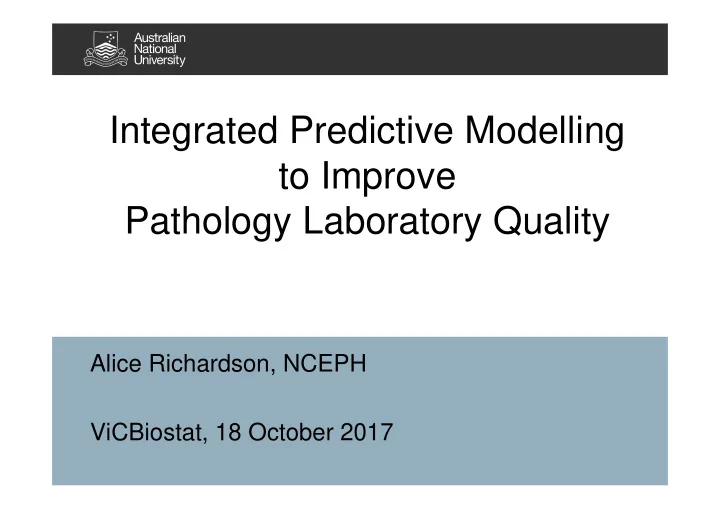

Integrated Predictive Modelling to Improve Pathology Laboratory Quality Alice Richardson, NCEPH ViCBiostat, 18 October 2017
Overview • NATA and QAP • Our study • Data • Results • Conclusions • The future
NATA • Audit report • Involves site visit and physical inspection • Up to 30 assessments against ISO 15189 clauses • Technical and Management
• O = observation • M1 = minor • Must be addressed to maintain accreditation, but not urgent • M2 = major • C = condition • could lose accreditation!
RCPAQAP External Quality Assurance • Mock samples sent by the RCPA • Arms length process unlike NATA • 16 cycles annually • Individual assay accuracy is the aim
Our study • 21 laboratories – 10 B: larger, full-time pathologist present – 11 G: smaller, supervised by B – Selected by linked data availability • 16 cycles of EQA data on 20 analytes • True value of analyte NOT given, use cycle sample mean for now
Research questions • What does a systematic review of literature reveal about the relationship between analytes and laboratory quality? • What is the distribution of O/M 1 /M 2 /C amongst laboratories of different types? • Can analyte data be used to predict quality (operationalised by the number or proportion of M 1 /M 2 /C)?
Text mining • MeSH terms: EQA, external quality assurance, ISO 15189, 15189, proficiency testing, pathology laboratory performance • 144 articles (1992 – 2016) • 37 out of scope, 6 no full text • Analyse 101 articles • R libraries tm , libsnowballC , wordcloud , cluster
• Interpretation in progress …
Distribution of M and C • Linear model – Outcome: – sum of M 1 + M 2 + C – Predictors: – type of clause (management or technical) – Type of lab (B or G)
• Significant differences between Technical and Management but not between B and G or Minor/Major and Condition
Predictive modelling • Random forest • Outcomes from NATA: (1) above or below median M count (2) above or below median C count • Predictors: from QAP, % Bias for 20 analytes � �� � � � � � � � � = assay value at time point i, lab j � = EQA assay value at time point i
• Absolute % Bias • Mean ±2 SEM • 21 labs and 16 time points combined • liver function tests, serum electrolytes and creatinine, and creatinine kinase (CK)
• Absolute % Bias • Mean ±2 SEM • 10 B labs • 11 G labs • liver function tests, serum electrolytes and creatinine, and creatinine kinase (CK)
• QAP results predict minor lab infractions from NATA inspections • OOB estimate of error rate: 14.29% L H error L 9 1 0.1 H 2 9 0.18
Investigating GGT variation
Explaining GGT variation • Serum K+ bias a strong predictor • Total M score significant • Lab category (B or G) not significant Source Df F P-value Lab category 1 2.5 0.134 Bicarbonate Bias 1 1.1 0.310 K+ Bias 1 27.27 < 0.001 Total M count 1 8.23 0.011 Error 16
Future work • Troponin turnaround time • 99 th percentile of troponin in multiple populations
Acknowledgements • QUPP of the DoH • RCPAQAP • NATA
Recommend
More recommend